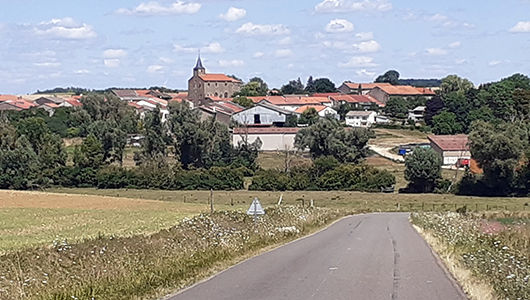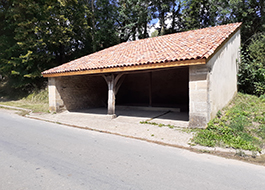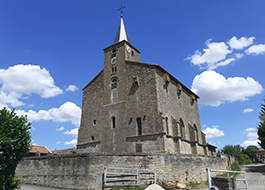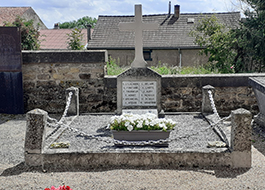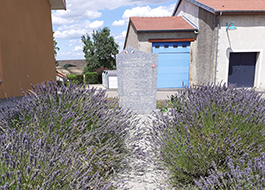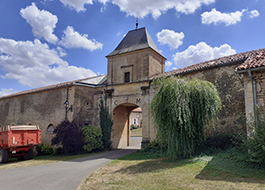Saint-Pierrevillers
Durée visite : 60 minutes
Moyen : Pédestre
Un édifice religieux est mentionné dés 950. Le village est affranchi dès 1278 par Thiebault, comte de Bar, et l’abbesse de Saint-Pierre-aux-Nonnains de Metz. Saint-Pierrevillers appartenait au Barrois et à la prévôté de Spincourt, pour la justice.
A religious building is mentioned in 950. The village was freed in 1278 by Thiebault, count of Bar, and the abbess of Saint-Pierre-aux-Nonnains de Metz. Saint-Pierrevillers belonged to the Barrois and the provostship of Spincourt, for justice.
Ein religiöses Gebäude wird 950 erwähnt. Das Dorf wurde 1278 von Thiebault, Graf von Bar, und der Äbtissin von Saint-Pierre-aux-Nonnains de Metz befreit. Saint-Pierrevillers gehörte den Barrois und der Provostschaft von Spincourt für die Gerechtigkeit an.

D’azur à deux clefs posées en chevron renversé d’argent, les pannetons ouvert, celui de dextre d’une croix recroisetée, celui de senestre d’une croix de Lorraine, accompagnées en chef d’une tour d’or.
Création Dominique Larcher. Adopté le 3 août 2006.
Azure with two keys set in chevron reversed Argent, the bitted open, that of dexter of a recrossed cross, that of sinister of a cross of Lorraine, accompanied in chief by a tower Or.
Created by Dominique Larcher. Adopted August 3, 2006.
Azurblau mit zwei Schlüsseln in Chevron, umgekehrtes Silber, die Bitts offen, das von Dexter eines neu gekreuzten Kreuzes, das von Finster eines lothringischen Kreuzes, begleitet von einem Turm oder.
Erstellt von Dominique Larcher. Angenommen am 3. August 2006.
Les points de visites
.
Il est construit au XIXe. Avec sa toiture à un pan de tuiles creuses, ce lavoir est un modèle sans confort, ouvert à tous les vents. La commune comptait alors 450 habitants.
It was built in the 19th century. With its one-sided roof of hollow tiles, this wash house is a comfortless model, open to all winds. The town then had 450 inhabitants.
Es wurde im 19. Jahrhundert erbaut. Mit seinem einseitigen Dach aus Hohlziegeln ist dieses Waschhaus ein trostloses Modell, offen für alle Winde. Die Stadt hatte damals 450 Einwohner.
.
 à ne pas manquer
à ne pas manquer
.
La magnifique église Saint-Rémy date des XIIe-XVe siècles. Elle est la mieux conservée des églises fortifiées de Meuse. De style roman, elle possède un chœur et un clocher édifiés en 1117, ainsi qu’une nef du XVe siècle. L’étage est accessible par un escalier. Il est constitué de marches numérotées et escamotables en chêne. Les villageois pouvaient ainsi s’y réfugier en cas d’attaque. Vous découvrirez une exposition permanente sur les églises fortifiées meusiennes, avec maquettes, panneaux, photographies.
The magnificent Saint-Rémy church dates from the 12th-15th centuries. It is the best preserved of the fortified churches of Meuse. Romanesque in style, it has a choir and a bell tower built in 1117, as well as a 15th century nave. The floor is accessible by a staircase. It consists of numbered and retractable steps in oak. The villagers could thus take refuge there in the event of an attack. You will discover a permanent exhibition on the Meuse fortified churches, with models, panels, photographs.
Die prächtige Kirche Saint-Rémy stammt aus dem 12. bis 15. Jahrhundert. Sie ist die am besten erhaltene befestigte Kirche der Maas. Im romanischen Stil hat es einen Chor und einen Glockenturm aus dem Jahr 1117 sowie ein Kirchenschiff aus dem 15. Jahrhundert. Der Boden ist über eine Treppe erreichbar. Es besteht aus nummerierten und einziehbaren Stufen aus Eiche. So konnten die Dorfbewohner im Falle eines Angriffs dort Zuflucht finden. Sie werden eine Dauerausstellung über die befestigten Kirchen an der Maas entdecken, mit Modellen, Tafeln, Fotografien.
.
Dans le cimetière de l’église se trouvent deux tombes collectives. L’une contient 12 corps de soldats français identifiés , l’autre 7 militaires français et 15 allemands, tous inconnus.
In the cemetery of the church are two collective graves. One contains 12 bodies of identified French soldiers, the other 7 French soldiers and 15 Germans, all unknown.
Auf dem Friedhof der Kirche befinden sich zwei Sammelgräber. Einer enthält 12 Leichen identifizierter französischer Soldaten, der andere 7 französische Soldaten und 15 Deutsche, alle unbekannt.
.
Cette stèle dédouble celle érigée dans l’église. Derrière les noms se cachent des destins divers. 12 enfants du village sont tombés en 14-18. Léon Mathieu est décédé en janvier 1919, dans un hôpital de Perpignan. Fait prisonnier en juin 1918, il a été rapatrié en décembre, visiblement malade. Les frères Ourth sont tombés, l’un au tout début de la guerre, l’autre à l’extrême fin. Les 3 Bertin sont des victimes civiles, décédés le 18 avril 1944 à Noisy-le-Sec, probablement dans un bombardement. Aimé Rouyer est mort 4 jours après l’armistice, accidentellement, en Loire-Atlantique. C’était un maquisard.
This stele duplicates the one erected in the church. Behind the names hide different destinies. 12 village children fell in 14-18. Léon Mathieu died in January 1919, in a hospital in Perpignan. Taken prisoner in June 1918, he was repatriated in December, visibly ill. The Ourth brothers fell, one at the very beginning of the war, the other at the very end. The 3 Bertins are civilian victims, who died on April 18, 1944 in Noisy-le-Sec, probably in a bombardment. Aimé Rouyer died 4 days after the armistice, accidentally, in Loire-Atlantique. He was a maquisard.
Diese Stele dupliziert die in der Kirche aufgestellte. Hinter den Namen verbergen sich unterschiedliche Schicksale. 12 Dorfkinder fielen in 14-18. Léon Mathieu starb im Januar 1919 in einem Krankenhaus in Perpignan. Im Juni 1918 gefangen genommen, wurde er im Dezember sichtlich krank repatriiert. Die Ourth-Brüder fielen, einer gleich zu Beginn des Krieges, der andere ganz am Ende. Die 3 Bertins sind zivile Opfer, die am 18. April 1944 in Noisy-le-Sec wahrscheinlich bei einem Bombenangriff starben. Aimé Rouyer starb 4 Tage nach dem Waffenstillstand versehentlich in Loire-Atlantique. Er war ein Maquisard.
 à ne pas manquer
à ne pas manquer
.
Cette bâtisse en pierre date des XVIIIe et XIXe siècles. Le hameau a été rattaché à Saint-Pierrevillers au XVIIe. L’ancien château avait abrité des troupes espagnoles pendant la guerre de Trente Ans. Un portail monumental, un corps de logis encadré de deux ailes à vocation agricole, deux bâtiments fermant l’ensemble constituent le nouvel édifice. Il a appartenu aux Launois, grands-parents du mathématicien Henri Poincaré.
This stone building dates from the 18th and 19th centuries. The hamlet was attached to Saint-Pierrevillers in the 17th century. The old castle had housed Spanish troops during the Thirty Years War. A monumental gate, a main building flanked by two agricultural wings, two buildings closing the whole make up the new building. It belonged to the Launois, grandparents of the mathematician Henri Poincaré.
Dieses Steingebäude stammt aus dem 18. und 19. Jahrhundert. Der Weiler wurde im 17. Jahrhundert an Saint-Pierrevillers angeschlossen. Die alte Burg beherbergte während des Dreißigjährigen Krieges spanische Truppen. Ein monumentales Portal, ein Hauptgebäude, flankiert von zwei landwirtschaftlichen Flügeln, zwei Gebäude, die das Ganze schließen, bilden das neue Gebäude. Es gehörte den Launois, den Großeltern des Mathematikers Henri Poincaré.

